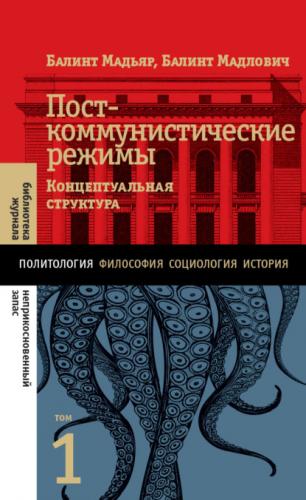Посткоммунистические режимы. Концептуальная структура. Том 1. Балинт Мадьяр
Читать онлайн книгу.J. Economics of Shortage. Amsterdam: North-Holland, 1980.
2
Kornai J. What the Change of System from Socialism to Capitalism Does and Does Not Mean // Journal of Economic Perspectives. 2000. Vol. 14. № 1. P. 29.
3
World Bank. Transition: The First Ten Years: Analysis and Lessons for Eastern Europe and the Former Soviet Union. Washington: World Bank, 2002; World Bank. Economies in Transition: An OED Evaluation of World Bank Assistance. Washington: World Bank, 2004.
4
Müller M. Goodbye, Postsocialism! // Europe-Asia Studies. 2019. Vol. 71. № 4. P. 533–550.
5
Карозерс Т. Конец парадигмы транзита // Политическая наука. 2003. № 2. С. 42–65.
6
Ledeneva А. The Global Encyclopaedia of Informality. Vol. 1. London: UCL Press, 2018.
7
Merton R. Sociological Ambivalence & Other Essays. New York: Free Press, 1976; Bourdieu P. In Other Words: Essays Toward a Reflexive Sociology. Stanford: Stanford University Press, 1990; Bauman Z. Modernity and Ambivalence // Theory, Culture and Society. 1990. Vol. 7. P. 143–169; Magyar B., Madlovics B. Stubborn Structures: A Path Dependence Explanation of Transitions in the Postcommunist Region // Social Research: An International Quarterly. 2019. Vol. 86. № 1. P. 113–146.
8
Дедуктивный метод предусматривает формулирование общих, оторванных от конкретных примеров теорий, с последующей их проверкой на основании эмпирических данных (прим. пер.).
9
North D. Institutions // Journal of Economic Perspectives. 1991. Vol. 5. № 1. P. 97–112; Ledeneva А. Unwritten Rules: How Russia Really Works. London: Centre for European Reform, 2001.
10
Эмический подход предполагает взгляд изнутри, глазами инсайдера, тогда как этический подход подразумевает взгляд снаружи, глазами стороннего наблюдателя (прим. пер.).
11
Индуктивный метод предполагает формулирование умозаключений на основе перехода от частных положений к общим, то есть снизу вверх (прим. пер.).
12
Fukuyama F. The End of History and The Last Man. New York: Free Press, 1992.
13
O’Donnell G., Schmitter P. Transitions from Authoritarian Rule: Comparative Perspectives. Baltimore; London: Johns Hopkins University Press, 1986; Diamond L., Linz J., Lipset S. M. Democracy in Developing Countries. London: Lynne Rienner, 1989.
14
Carothers T. Democracy Assistance: The Question of Strategy // Democratization. 1997. Vol. 4. № 3. P. 109–132; Idem. Aiding Democracy Abroad: The Learning Curve. Washington: CEIP, 1999.
15
Holmes S. Democracy for Losers // Brave New Hungary: Mapping the «System of National Cooperation». Lanham: Lexington Books, 2019. P. 291–302.
16
Sen A. Democracy as a Universal Value // Journal of Democracy. 1999. Vol. 10. № 3. P. 3–17.
17
Schmitter P., Karl T. The Conceptual Travels of Transitologists and Consolidologists // Slavic Review. 1994. Vol. 53. № 1. P. 173–185; Bunce V. Should Transitologists Be Grounded? // Slavic Review. 1995. Vol. 54. № 1. P. 111–127; Levitsky S., Way L. Competitive Authoritarianism: Hybrid Regimes after the Cold War. Cambridge: Cambridge University Press, 2010.
18
Carothers T. The End of the Transition Paradigm // Journal of Democracy. 2002. Vol. 13. № 1. P. 5–21; Levitsky S., Way L. Competitive Authoritarianism: Hybrid Regimes after the Cold War.
19
См. например, критический метаанализ этих изменений: Cassani A. Hybrid What? Partial Consensus and Persistent Divergences in the Analysis of Hybrid Regimes // International Political Science Review. 2014. Vol. 35. № 5. P. 542–558.
20
См. например, критический метаанализ: Bogaards M. Where to Draw the Line? From Degree to Dichotomy in Measures of Democracy // Democratization. 2012. Vol. 19. № 4. P. 690–712.
21
Bunce V. Should Transitologists Be Grounded? P. 112. Ср.: Sartori G. Comparing and Miscomparing // Journal of Theoretical Politics. 1991. Vol. 3. № 3. P. 243–257.
22
Хантингтон С. Третья волна. Демократизация в конце XX века. М.: РОССПЭН, 2003.
23
Zakaria F. The Rise of Illiberal Democracy // Foreign Affairs. 1997. Vol. 76. № 6. P. 22–43.
24
Хантингтон С. Третья волна; O’Donnell G., Schmitter P. Transitions from Authoritarian Rule: Comparative Perspectives. Baltimore and London: Johns Hopkins University Press, 1986; Schmitter P. Transitology: The Science or the Art of Democratization? // The Consolidation of Democracy in Latin America. Boulder: Lynne Rienner, 1995. P. 11–41; Przeworski A. Transitions to Democracy // Democracy and the Market. Cambridge: Cambridge University Press, 1991. P. 51–99.
25
Linz J., Stepan A. Problems of Democratic Transition and Consolidation: Southern Europe, South America, and Post-Communist Europe. Baltimore; London: Johns Hopkins University Press, 1996; Mainwaring S., O’ Donnell G., Valenzuela J. S. Issues in Democratic Consolidation: New South American Democracies in Comparative Perspective. Notre Dame: University of Notre Dame Press, 1992; Diamond L. Developing Democracy: Toward Consolidation. Baltimore: Johns Hopkins University Press, 1999.
26
Schimmelfennig
